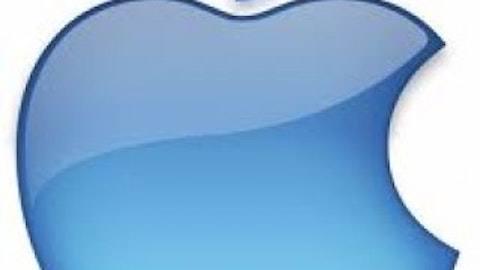Google Inc (NASDAQ:GOOG) and Microsoft Corporation (NASDAQ:MSFT) are at one another’s throats in a very public way right now. This quarrel might contain clues on what’s next for Google Inc (NASDAQ:GOOG)’s YouTube service.
Microsoft Corporation (NASDAQ:MSFT) baked up a premium Windows Phone app for the popular YouTube video service, but Big G blocked it because Microsoft didn’t include ad functions. The app could also download YouTube videos and play content that wasn’t supposed to work on mobile devices.
So it was back to the drawing board. Microsoft Corporation (NASDAQ:MSFT) and Google Inc (NASDAQ:GOOG) announced that they’re working together to get a full-featured YouTube app into the Windows app store; Meanwhile, Windows Phone users had to fall back on the original YouTube app for that platform, which is widely seen as far inferior to the banned one.

Problem solved, right? The warring parties are smoking a peace pipe in the coding room, probably over a half-eaten pizza and some laser chicken.
Will Microsoft’s mobile platform ever get a proper YouTube app? Only if Redmond plays ball with Mountain View. Image source: YouTube.
It’s never that easy
But that partnership hit a new snag this week. Redmond introduced a new YouTube app for its mobile platform, and it looked like the banned one with a sprinkle of advertising support on top. It also allowed video uploads from the phone, which is a new feature for Windows Phone YouTube apps.
Aaaand … that version got the cold shoulder from Google Inc (NASDAQ:GOOG)’s side of the fence, too. This was clearly not the app that the joint development team was working on, but a rewarmed take on the forbidden fruit.
YouTube blames the disconnect on limitations in Microsoft Corporation (NASDAQ:MSFT)’s mobile browser code. These technical headwinds made it impossible to work up a browser-based HTML5 app to access YouTube videos, which was a firm requirement for access to YouTube’s programming interfaces. So the Microsoft guys fell back on the old code instead, over Google Inc (NASDAQ:GOOG)’s protests.
The other side of the story
Microsoft Corporation (NASDAQ:MSFT) doesn’t feel responsible for the controversy at all. In a long blog post, general counsel David Howard fought back against the very idea that Redmond was doing something wrong.
“At the end of the day, experts from both companies recognized that building a YouTube app based on HTML5 would be technically difficult and time-consuming, which is why we assume YouTube has not yet made the conversion for its iPhone and Android apps,” Howard said. And that’s why the rereleased app was built on the old code base rather than on the newfangled HTML5 programming platform. “The roadblocks Google Inc (NASDAQ:GOOG) has set up are impossible to overcome, and they know it.”
What’s really going on here?
Here’s what I think is happening. Google and YouTube are legitimately interested in making HTML5 the gold standard for YouTube viewing. So it’s a bad idea to introduce brand new apps on a deprecated, obsolete coding platform.
Microsoft Corporation (NASDAQ:MSFT) objects that Android and iOS apps still don’t use the HTML5 standard. But I fully expect them to, and soon. The old apps built on native Android and iOS code is just grandfathered in until their replacements are ready for prime time.
Here’s one fact to support this view: The browser-based YouTube site is slowly making the transition as we speak.
HTML5 viewing has long been available as an experimental add-on. But it wasn’t fully compatible with video ads. Even if you signed up for that experiment, you’d still often get kicked out to the standard model using the Flash browser plugin.
Now, YouTube has quietly implemented a fresh HTML5 framework if you’re using Google’s Chrome browser to view the site. The new model loads the next video faster and ad features seem to work across the board now. This is no longer an opt-in lab feature but the new standard. It’s not everywhere yet but that’s just temporary.
What’s next?
So I expect this model to saturate the entire YouTube ecosystem in short order, starting with a deeper cross-platform browser experience and then followed by mobile apps that take advantage of the basic website’s code. Microsoft Corporation (NASDAQ:MSFT) may have to make fundamental changes to its mobile Internet Explorer browser to keep up. I think it’s about supporting Google’s WebM and VP8 digital video technologies, which are kind of a big deal for Google Inc (NASDAQ:GOOG) and not supported at all by Microsoft.
In other words, this boils down to Google wanting to simplify the entire YouTube ecosystem, leveraging its preferred video technologies in the process. If Microsoft wants a fully featured Windows Phone app for the new paradigm, the company will eventually have to play ball with Google’s fundamental technology demands.
The article Google Wants Microsoft to Build a Better Browser originally appeared on Fool.com and is written by Anders Bylund.
Fool contributor Anders Bylund owns shares of Google, but he holds no other position in any company mentioned. Check out Anders’ bio and holdings, or follow him on Twitter and Google+.The Motley Fool recommends Google and owns shares of Google and Microsoft.
Copyright © 1995 – 2013 The Motley Fool, LLC. All rights reserved. The Motley Fool has a disclosure policy.





